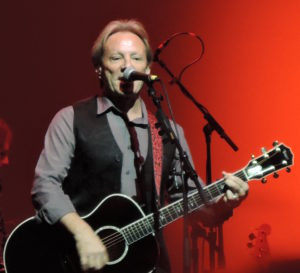For decades, the song “A Horse With No Name” by the band America has captivated listeners with its hypnotic rhythm and enigmatic lyrics. The track, instantly recognizable from its opening acoustic guitar riff, climbed to the top of the Billboard charts in the 1970s and has remained a staple on classic rock radio ever since. Yet, despite its enduring popularity, the true meaning behind the song has often been shrouded in speculation, with many listeners pondering the significance of its titular equine.
 Dewey Bunnell of the band America performing live, showcasing his role as the songwriter and lead vocalist for "A Horse With No Name."
Dewey Bunnell of the band America performing live, showcasing his role as the songwriter and lead vocalist for "A Horse With No Name."
Adding to the song’s mystique is a popular internet meme that playfully questions the nameless horse, quipping, “All I’m saying is, at any point during that ride through the desert, he could have given that horse a name.” This humorous observation, often shared among fans and casual listeners alike, highlights the central lyrical anomaly that has fueled countless interpretations of the song’s message.
However, the story behind “A Horse With No Name” is more nuanced than a simple desert journey with an unnamed animal. Written and sung by Dewey Bunnell, one of the founding members of America alongside Gerry Beckley and Dan Peek, the song emerged during a pivotal time for the band. Initially, their self-titled debut album in 1971 did not feature the track. It was only after “A Horse With No Name” resonated deeply with audiences and soared to the number one spot on the U.S. Billboard Hot 100 in 1972 that the album was re-released, now including the hit single that had propelled them to international fame.
Interestingly, the controversy surrounding “A Horse With No Name” wasn’t centered on the horse’s lack of appellation, but rather on accusations of drug references. The term “horse” is, in some circles, slang for heroin, leading some radio stations to initially hesitate in playing the song, fearing veiled allusions to drug use within its lyrics.
Yet, according to the songwriter himself, these interpretations are far from the intended meaning. Dewey Bunnell has consistently refuted the drug allegations in interviews over the years. Speaking in a 2006 interview, and reiterating in subsequent conversations, Bunnell clarified the true inspiration and message behind “A Horse With No Name.”
“Not at all,” Bunnell firmly stated regarding the drug rumors. He explained that the core theme of the song was rooted in “solitary thinking in a peaceful place.” The desert landscape, vividly evoked in the lyrics, was not a metaphor for drug-induced escapism, but rather a setting for introspection and tranquility. “The horse was really just a vehicle to get out there,” Bunnell elaborated. “I always loved the desert as a kid. ‘The heat was hot’ was an important feeling that I was trying to re-create there. [The song] was just a travelogue with an environmental message in there about saving the planet.”
Bunnell’s explanation paints a picture of the song as a journey of the mind, using the stark and serene imagery of the desert as a backdrop for contemplation. The “horse with no name” becomes a symbolic mode of transport, carrying the listener away from the noise and distractions of everyday life and into a space of quiet reflection. The environmental undertones, mentioned by Bunnell, further enrich the song’s meaning, suggesting a yearning for a simpler, more harmonious existence in tune with nature.
Adding a touch of irony to the narrative, Bunnell recounted a story related to the band’s third album, “Hat Trick,” released in 1973. For the album cover photoshoot, horses were indeed involved, and band members ventured into the desert to capture the visual aesthetic. “We had fun, but I don’t recall the name of the horse I rode while I was out there,” Bunnell admitted. “A lot of horse people think I have a real working knowledge of the animal, but I don’t.”
This anecdote playfully mirrors the very question posed by the popular meme. Even when presented with an actual horse in a desert setting, Bunnell’s focus remained elsewhere, perhaps reinforcing the symbolic nature of the horse in his iconic song.
So, the next time you hear the opening chords of “A Horse With No Name,” remember that it’s more than just a catchy tune about a desert ride. It’s an invitation to find your own peaceful place, to engage in solitary thought, and to appreciate the world around you – even if the soundtrack features a horse that, quite deliberately, remains unnamed. And perhaps, the namelessness of the horse is precisely the point, allowing it to become a universal symbol for that quiet journey we all sometimes need to take within ourselves.
